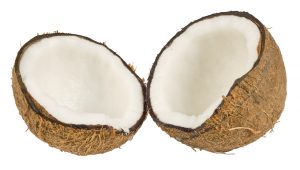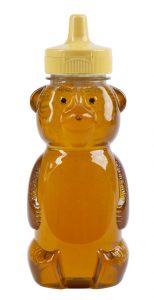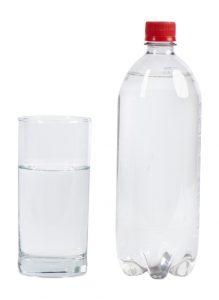The ‘Fake News’ Of Sports Nutrition
Every year, it seems, there’s a new magic bullet in sports nutrition. Here, we debunk six of the biggest myths.
When it comes to nutrition, everyone is an expert. Magazine articles, blogs, and daytime TV hosts are all quick to offer up sage advice—and the public eats it up (pun intended). The field of sports nutrition is no exception as, more and more, athletes look to their diets to give them an edge on the competition.
Unfortunately, not all of the advice is correct and pervasive myths mislead even the savviest. Check out the facts behind these sports nutrition myths so that you won’t be yet another victim of “fake news.”
 Myth 1. Coconut oil is a superfood for athletes.
Myth 1. Coconut oil is a superfood for athletes.
Just as Bill Cosby went from national treasure to controversial pariah, coconut oil is no longer America’s sweetheart. In fact, few foods have experienced such widespread love and devotion only to be followed by an equally rapid fall from grace.
In the 1950s, coconut oil was used regularly in frying and baking. What served as a staple item in many kitchens was phased out, however, when research linked saturated fats to heart disease. As medical professionals began warning consumers to avoid foods high in saturated fat, butter, high-fat meats and coconut oil quickly became taboo. Instead, dietary guidelines urged us to opt for vegetable oils, all but removing coconut oil from most household kitchens.
Coconut oil remained on the out until recent years when it took top spot as the latest and greatest “superfood.” Claims about coconut oil ranged from it being a weight loss magic bullet to a possible cure for Alzheimer’s. All of a sudden, coconut oil was being added to smoothies, energy bars and even coffee. Health bloggers and foodies alike touted using coconut oil in place of other fats for a health and flavor boost.
Why the sudden shift? In 2003, a study delved into the impact of different types of saturated fats on health. Yes, you read that correctly; not all saturated fats behave the same way in the body and thus their impact differs.
Medium-chain triglycerides (MCTs) are saturated fats that have shorter chains and, as a result, are digested and absorbed differently. Their shorter length allows them to travel directly to the liver after being absorbed from the digestive tract, where they can be burned immediately for energy. This differs from long-chain triglycerides (LCTs), which are ultimately transported in the blood to fat cells where they are deposited for storage.
The study found that individuals with a diet containing higher levels of MCTs lost more weight than those consuming a diet high in LCTs. Follow up studies compared a diet high in MCTs to a diet high in olive oil and, once again, MCTs provided more weight loss. In addition, MCTs did not raise cholesterol as other saturated fats did.
As you may have surmised, it just so happens that the saturated fats in coconut oil are largely MCTs. With that, coconut oil came out of obscurity and into seemingly every pantry in America. In fact, since that study came out, coconut oil has been widely incorporated into processed goods and has found a place alongside butter and even olive oil for use in cooking and baking.
The proposed mechanism of MCT absorption and transport in the body piqued the interest of athletes as well. In addition to its purported health benefits, athletes jumped at the idea that coconut oil could deliver a rapid source of energy that could supplement or even replace carbohydrates during exercise.
However, coconut oil’s reign was not meant to last. Recently the American Heart Association once again blacklisted coconut oil, citing studies that showed coconut oil is the health equivalent of other foods high in saturated fat like butter and palm oil. In fact, coconut oil boasts an even higher saturated fat content than lard. Just two tablespoons packs in 20 grams of saturated fat; the maximum daily amount recommended for females.
What’s worse, the claims associated with MCT’s didn’t actually bear out. Upon closer examination, we now know that studies cited to support the use of coconut oil did not actually use coconut oil, but instead relied on the use of MCT oil. Of the fat contained in MCT oil, 95-percent can be rapidly burned for energy. However, the MCTs in coconut oil are slightly longer and, as a result, are processed differently, with only 25- to 30-percent being transported to the liver for quick conversion to energy. Translation: while the claims of health benefits from MCTs are well-founded, they can’t be extrapolated and applied to the fats in coconut oil.
Bottom line: For athletes, this means that alleged rapid energy source isn’t all it’s cracked up to be. In fact, consumption of coconut oil prior to exercise can negatively impact performance. If you are still looking for the benefit of an easy-to-access energy source other than carbohydrates, MCT oil is an option. However, athletes should be aware that studies on MCT oil use prior to exercise have not shown any improvement in performance. There are also potential negative side effects like gastrointestinal distress.
Myth 2. Eliminating gluten is good for health and performance.
With approximately one-third of Americans avoiding gluten—the protein found in wheat, barley, rye and some other grains—going gluten-free has grown from a health fad to an all-out movement in the United States. Those who shun gluten claim that our body is not adapted to consuming the protein and doing so can lead to everything from digestive distress to weight gain and fatigue.
Athletes are no exception and many, even at elite levels, now subscribe to a gluten-free diet or try to avoid it as much as possible. Though some athletes may claim that eliminating gluten-containing grains has given them a boost in performance and reduced their digestive issues, research suggests otherwise.
For example, one recent study compared the cycling performance of athletes following a gluten-free diet versus high-gluten diet. The results showed absolutely no difference in performance, inflammatory markers or digestive issues.
Bottom line: If going gluten free doesn’t necessarily help, is there any real harm? The concern is that many gluten-free alternatives are more highly processed and are lower in nutrients than their gluten-containing counterparts. This is not to suggest, however, that a gluten-free diet holds no merit. For those with celiac disease or gluten sensitivity, gluten should be eliminated altogether. The best solution is to eat whole grains that are naturally gluten-free, such as quinoa, corn or rice.
 Myth 3. Honey and maple syrup are better than sugar.
Myth 3. Honey and maple syrup are better than sugar.
We all know full well that our sugar intake should be kept as low as possible. However, what constitutes sugar has proven to be a divisive issue. Most would agree that if you add a tablespoon of sugar to your coffee or oatmeal you might as well eat a bowl of Frosted Flakes. But add a tablespoon of honey or maple syrup, and many people feel downright wholesome.
Unfortunately, the health halo that seems to surround honey and maple syrup is misleading. There’s no question that white sugar provides nothing more than calories, but maple syrup and honey aren’t exactly nutritional all-stars. While honey and maple syrup do provide some nutrients, such as traces of B vitamins, the amounts of these vitamins are small, and both honey and maple syrup pack a lot of sugar and calories.
Bottom line: Metabolically, the body doesn’t care whether your added sugar intake comes from refined white sugar or pure maple syrup. In the end, excess calories, particularly from sugar, lead to weight gain. This issue comes up for athletes when selecting fueling products like gels and sports drinks that consist primarily of simple sugars. The push back against sugar has created a niche market for “natural” fueling products that use honey or maple syrup to provide power for the long haul. If this is your preference and you find these products work for you, then by all means, go for it. But if you are choosing to forego your favorite gel because you are trying to avoid all of that “bad” processed sugar, you can rest (or run) assured: it doesn’t matter either way. Stick with what you feel and perform best with.
Myth 4. Muscle cramps are caused by dehydration or an electrolyte imbalance.
Nearly every endurance athlete has a harrowing story to tell of a race in which he or she succumbed to the pain of a muscle cramp. Experiencing this once is usually enough for athletes to seek out a solution so they never have to see a PR slip away again, thanks to a seized-up calf or hamstring.
It is widely believed that muscle cramps are caused by dehydration or an electrolyte imbalance. Therefore, the seemingly obvious solution is to consume more sports beverages throughout the race or use electrolyte replacements. While this can be a smart strategy for overall performance, unfortunately, it will do nothing for those cramps. The theories on dehydration and electrolyte imbalance are based on dated and poorly-designed studies that have since been discredited.
Bottom line: Muscle cramps are actually caused by neuromuscular fatigue. Essentially, the muscle cramps because it is being exerted above and beyond normal levels. Think about it: How often do muscle cramps occur when you are just out for a casual run versus a competitive race? If you have been plagued by muscle cramps in the past, then the solution is to examine your training and ensure that your intensity when racing is reflective of your training.
 Myth 5. You can’t drink too much water.
Myth 5. You can’t drink too much water.
Most athletes have it drilled into them from an early age that dehydration is a common problem that can negatively impact performance. The obvious solution: drink a lot and drink often, especially when exercising in the heat. While it is true that dehydration can have adverse performance and even health consequences, you can have too much of a good thing.
That’s right, you can overdo it on water, and the potential consequences can land you in the hospital or, even worse, result in death.
Hyponatremia is a condition in which the level of sodium in the blood is abnormally low. By consuming too much water, sodium in the blood becomes diluted. This, in turn, causes cells in the body to swell, resulting in symptoms like nausea, vomiting, headache, confusion, fatigue, irritability and loss of consciousness. Experts speculate that overblown fears of dehydration have pushed many recreational athletes to drink far more than is recommended or needed. In fact, a study of Boston Marathon finishers found that 13 percent were hyponatremic upon completing the race.
Bottom line: To avoid the potential performance or health consequence of hyponatremia, the best thing athletes can do is to listen to their body by using thirst as their guide.
Myth 6. Athletes need to take a multivitamin.
Surveys have shown that approximately 85 percent of elite athletes use at least one supplement, the most common of which is a multivitamin. That seems to make sense.
Athletes sweat out a lot of vitamins and minerals. Plus they need extra antioxidants to deal with the stress exercise puts on their bodies, right? Wrong.
An athlete’s vitamin and mineral needs are not drastically different from those of sedentary individuals with only a few minor exceptions. Barring any significant food restrictions, most athletes get adequate vitamins and minerals naturally from food. Scientists have found that the vitamin and mineral content of natural foods are in the ideal proportion to allow for optimal absorption. Of course, meeting one’s nutrient needs without supplementation hinges on one very important detail: the quality of your diet. Athletes have to consume a variety of nutrient-dense foods in order to meet their needs. Unfortunately, “nutrient-dense” isn’t exactly what jumps to mind with the standard American diet.
Bottom line: Processed foods are often stripped of their naturally-occurring vitamins and minerals, increasing the likelihood of a vitamin or mineral deficiency among those who rely heavily on these foods; athlete or not. If you are concerned you may be missing out on key nutrients, meet with a registered dietitian to evaluate the quality of your diet and determine if a multivitamin or other supplement may help.
Jamie Sheahan, M.S., R.D. is the Director of Nutrition at The Edge in Burlington where she works closely with athletes to develop custom fueling plans to optimize health and performance. Sheahan is also an adjunct professor of sports nutrition at University of Vermont and an avid runner.




Pingback: Vermont Sports Magazine, March/April 2018 - Vermont Sports Magazine